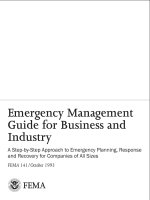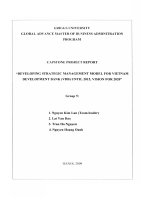Strategic management planning for domestic and global competition 14th ed pearce robinson chapter 13
Bạn đang xem bản rút gọn của tài liệu. Xem và tải ngay bản đầy đủ của tài liệu tại đây (415.36 KB, 29 trang )
Chapter 13
Strategic Control
© 2015 by McGraw-Hill Education. This is proprietary material solely for authorized instructor use. Not authorized for sale or distribution in any manner. This document may not be copied, scanned, duplicated, forwarded, distributed, or
posted on a website, in whole or part.
Learning Objectives
1.
2.
Describe and illustrate four types of strategic control.
Summarize the balanced scorecard approach and how it integrates strategic and
operational control.
3.
Illustrate the use of controls to guide and monitor strategy implementation.
2
Strategic Control
•
Management efforts to track a strategy as it is being implemented, detect
problems or changes in its underlying premises, and make necessary
adjustments.
3
Questions That Drive Strategic Control
1.
2.
Are we moving in the proper direction?
How are we performing?
4
Types of Strategic Control
•
•
•
•
Premise control
Strategic surveillance
Special alert control
Implementation control
5
Ex. 13.1
Four Types of Strategic Control
Cha pter 13 exhibit 1.CLP
6
Ex. 13.1 (contd.)
Characteristics of the Four Types of Strategic Control
Cha pter 13 exhibit 2.CLP
7
Premise Control
•
Premise control is designed to check systematically and continuously whether
the premises on which the strategy is based are still valid
•
Primarily concerned with
–
–
Environmental factors
Industry factors
8
Strategic Surveillance
•
Strategic surveillance is designed to monitor a broad range of events inside and
outside the firm that are likely to affect the course of its strategy
•
•
Strategic surveillance must be kept as unfocused as possible
Despite its looseness, strategic surveillance provides an ongoing, broad-based
vigilance in all daily operations
9
Special Alert Control
•
•
•
•
A special alert control is the thorough, and often rapid, reconsideration of the firm’s
strategy because of a sudden, unexpected event
A drastic event should trigger an immediate and intense reassessment of the firm’s
strategy and its current strategic situation
Crisis teams
Contingency plans
10
Implementation Control
•
Implementation control is designed to assess whether the overall strategy should
be changed in light of the results associated with the incremental actions that
implement the overall strategy
11
Implementation Control (contd.)
•
•
•
The two basic types of implementation control are:
Monitoring strategic thrusts
Milestone reviews
12
Strategic Thrusts or Projects
•
Special efforts that are early steps in executing a broader strategy, usually
involving significant resource commitments yet where predetermined feedback
will help management determine whether continuing to pursue the strategy is
appropriate or whether it needs adjustment or major change.
13
Milestone Reviews
•
Points in time, or at the completion of major parts of a bigger strategy, where
managers have predetermined they will undertake a go-no go type of review
regarding the underlying strategy associated with the bigger strategy.
14
Operational Control Systems
•
To be effective, operational control systems must take four steps common to all postaction
controls:
– Set standards of performance
– Measure actual performance
– Identify deviations from standards set
– Initiate corrective action
15
The Balanced Scorecard Methodology
•
An alternative approach linking operational and strategic control, developed by
Harvard Business School professors Robert Kaplan and David Norton, is a system
they named the balanced scorecard
16
Balanced Scorecard
•
A management control system that enables companies to clarify their strategies,
translate them into action, and provide quantitative feedback as to whether the
strategy is creating value, leveraging core competencies, satisfying the company’s
customers, and generating a financial reward to its shareholders.
17
Kaplan and Norton on the Balanced Scorecard
•
“The balanced scorecard retains traditional financial measures. But financial
measures tell the story of past events, an adequate story for industrial age
companies for which investments in long-term capabilities and customer
relationships were not critical for success. These financial measures are
inadequate, however, for guiding and evaluating the journey that information
age companies must make to create future value through investment in
customers, suppliers, employees, processes, technology, and innovation.”
18
Ex. 13.5 Integrating Shareholder Value and Organizational Activities across Organizational Levels
19
Balanced Scorecard
Four perspectives:
1.
The learning and growth perspective: How well are we continuously improving and
creating value?
2.
The business process perspective: What are our core competencies and areas of
operational excellence?
20
Balanced Scorecard Perspectives (contd.)
1.
2.
The customer perspective: How satisfied are our customers?
The financial perspective: How are we doing for our shareholders?
21
Ex. 13.6
Exxon’s NAM&R Division’s Balanced Scorecard
22
Ex. 13.6 (contd.)
Strategic Objectives
Strategic Measures
23
Ex. 13.6 (contd.)
Strategic Objectives
Strategic Measures
24
Ex. 13.6 (contd.)
Strategic Objectives
Strategic Measures
25









